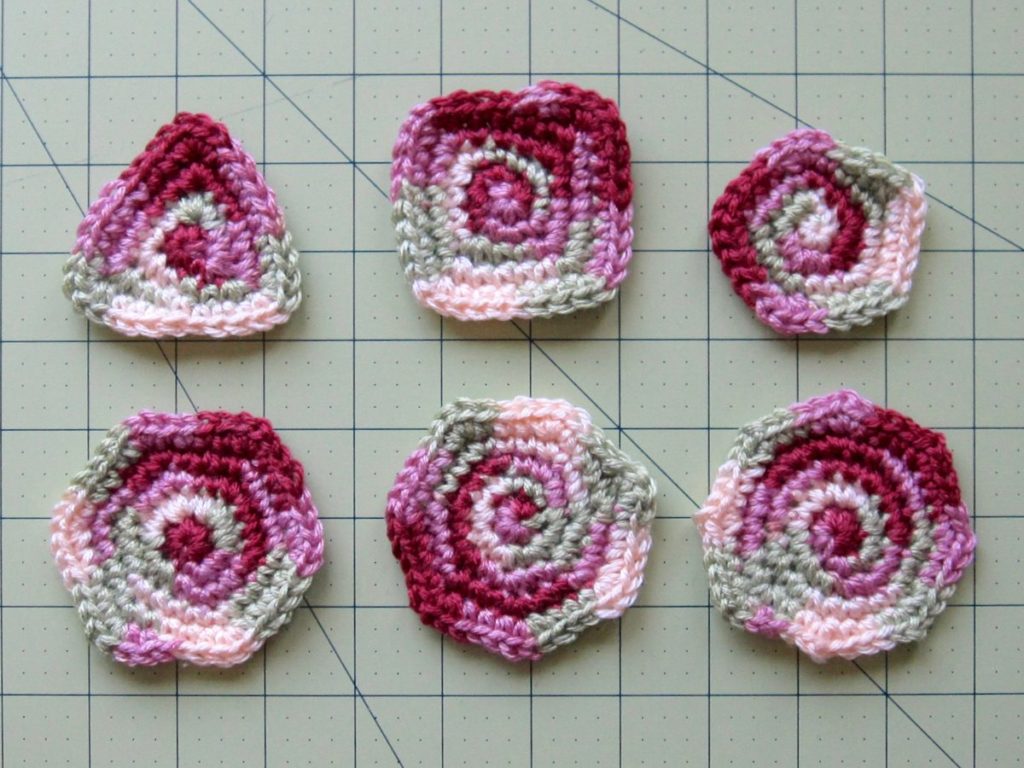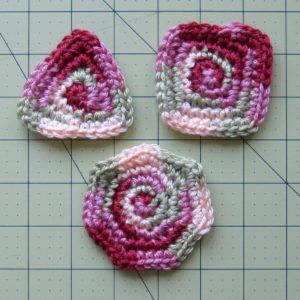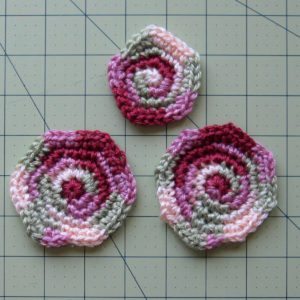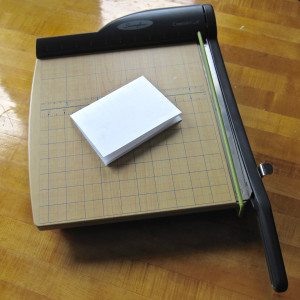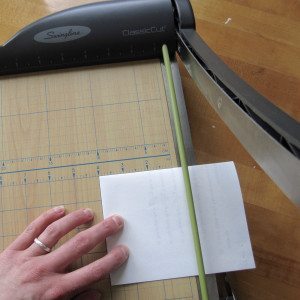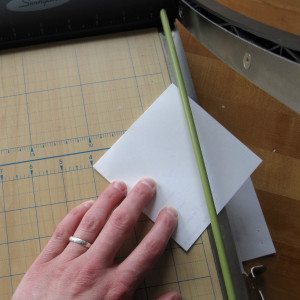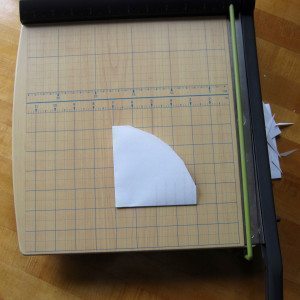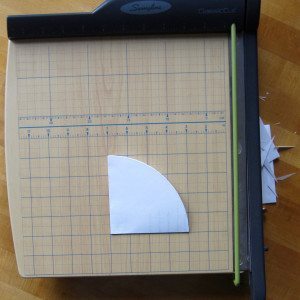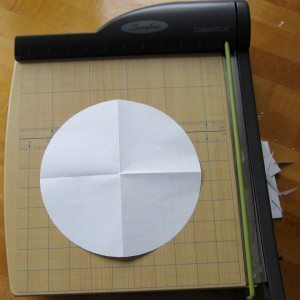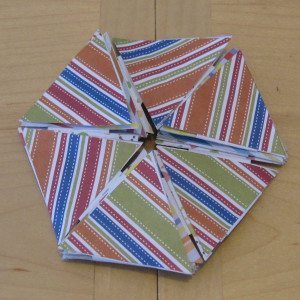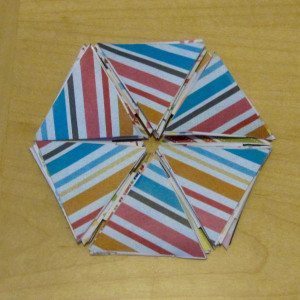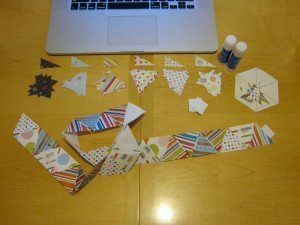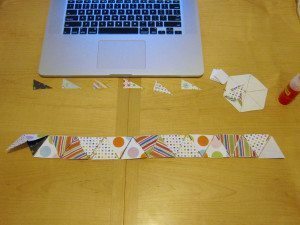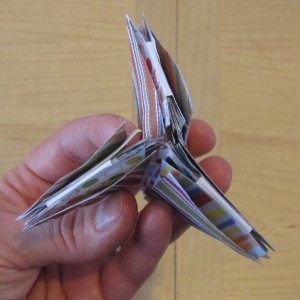If you want to crochet a smooth disk, you should stagger the increases round to round. If they stack up on top of each other they tend to make corners. If you want something with corners, though, can you figure out how to make it without pure trial and error? In particular, if you want to make regular polygons of various numbers of sides, how do you figure out how to increase?
Being who I am, I began with geometry. A disk takes 6 or 7 increases around because when you increase the radius of a circle by 1 unit (i.e. by one round) the perimeter increases by 2π units, 6.28ish. We have to fudge a little, of course, since an sc doesn’t add exactly the same amount to circumference as to radius and we can only increase by whole stitches, but it works out; we are able to make disks.
For a polygon, there are two distances that could play the role of the circle’s radius: center to corner (radius), and center to edge midpoint (apothem). We have formulas that tell you how much the perimeter increases when the radius or apothem increases by 1, depending only on the kind of polygon you’re expanding.
Shockingly, I’ve decided not to go into the algebra here; you can read all about it Math Open Reference. My previous knowledge says you need 8 extra stitches for a square, and that number should be larger for fewer sides and smaller for more sides (you need more stitches to get around pointier corners). Those both matched the apothem calculation and not the radius calculation.
| polygon | extra stitches per round from apothem formula |
|---|---|
| triangle | 10.4 |
| square | 8 |
| pentagon | 7.3 |
| hexagon | 6.9 |
| heptagon | 6.7 |
| octagon | 6.6 |
The apothem numbers leave a lot to be worked out: how to round, what to do when the increases aren’t a multiple of the number of sides, and whether an octagon could even be made when it called for fewer increases per round than corners. I made all six polygons more or less successfully, but they broke out into half easier, half harder.
The easy polygons were the triangle, square, and heptagon.
Triangle: This didn’t go how I expected – I thought I would need to round up to 12 extra stitches per round, but I actually dropped down to 9. I started with 6 sc in a magic ring, and every corner got 4sc. Increases made into previous increases went into the third of the four sc.
Square: As I said, I already knew to put 3sc into the corners to make a square. I started with 6 sc, increased around, and then started making concentrated increases for corners. Increases made into previous increases were made into the middle sc.
Heptagon: Since for me, seven increases is appropriate for making a flat disk, the heptagon was straightforward. YMMV. I started with seven stitches, increased around, and then increased in the second stitch of each previous increase. To improve the point of the corners, in the last round I made 3sc into the second stitch of every previous round increase.
Pentagon, hexagon, and octagon were more difficult, but they did work reasonably well.
Pentagon: The pentagon formula called for 7.3 new stitches per round. Since five 2sc increases would add 5 and five 3sc increases would add 10, I alternated between them: start with 5 sc in a magic ring and make 3sc into each of them. Next round, put 2sc into the center of each 3sc increase; round after that, put 3sc into the second of each 2sc increase. Continue alternating, ending on a 3sc round. I did attempt mixing 2sc and 3sc increases within individual rounds, but it was a mess to keep the side lengths equal.
Hexagon: Like the pentagon, I used a combination of 2sc and 3sc increase rounds. The hexagon’s apothem number was lower and the number of increases per round higher (6 or 12) so I made two 2sc increase rounds for every one 3sc increase round. It perhaps would be even better to make three 2sc rounds per 3sc round, but I worried about maintaining the flatness of the piece. Start with 6 sc in a magic ring, make 3sc into each of them, and then make two rounds of 2sc increasing and one of 3sc. Put your increases into the second stitch of a 2sc predecessor or the middle stitch of a 3sc predecessor, and for best results end on a 3sc round.
Octagon: How can one even make an octagon if even one increase per corner leads to too many stitches around for the piece to stay flat? I suspect the best answer is to make a disk large enough to naturally hit a multiple of 8 stitches around and then do something like (sc, hdc, sc) in each corner on the last round. I wanted to try to stick to the size and methods of the other polygons (though I didn’t quite) and ended up with this: 7 sc in a magic ring; 2sc around; *2sc, sc* around. You’re at 21 stitches. Make a big jump to 32: *2sc, sc* 10 times, 2sc. Last round: sc 2, *(sc, ch, sc), sc 3* 7 times, (sc, ch, sc), sc. The chain in the middle of the last round’s increases gives it a little bit more point without adding even more extra bulk than we already have.
There you have it: all the polygons from 8 sides down rendered in crochet, for your freeform delight. I did these all in spirals and ended with a needle join in the second stitch; the ultimate perimeter would be smoother if you worked in joined rounds.
